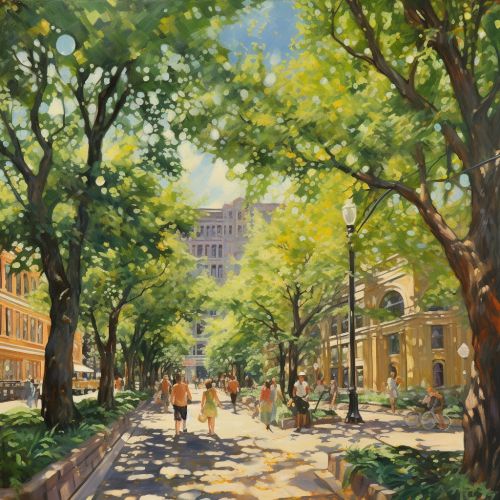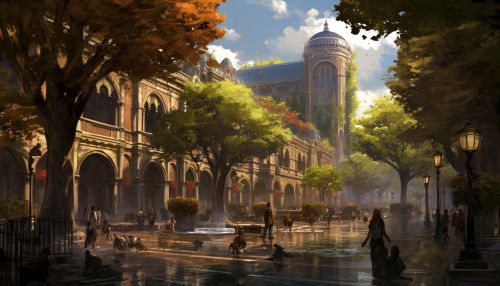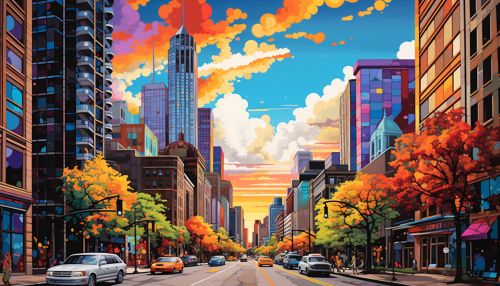Urban Design
Introduction
Urban design is a multidisciplinary practice that involves the arrangement and design of buildings, public spaces, transport systems, and other elements in urban environments. It is an integral part of urban planning and architecture. Urban design seeks to create sustainable urban environments with long-lasting structures, efficient use of resources, and overall improvement in quality of life.
History
The history of urban design dates back to ancient civilizations. The Greeks, for instance, planned their cities with a focus on public spaces and buildings. The Romans, on the other hand, emphasized infrastructure such as roads and aqueducts. In the Middle Ages, urban design was largely dictated by defensive needs, leading to the creation of fortified walls and castles. The Industrial Revolution brought about significant changes in urban design, with the introduction of factories, railways, and housing for workers.


Principles of Urban Design
Urban design is guided by several key principles. These include:
- Sustainability: This involves designing urban spaces in a way that minimizes environmental impact and promotes long-term ecological balance. It includes considerations such as energy efficiency, waste management, and the use of renewable resources.
- Livability: Urban design should enhance the quality of life for residents. This includes creating safe, comfortable, and attractive environments, with access to necessary amenities and services.
- Identity: Urban design should reflect and enhance the unique characteristics and culture of the local community. This includes preserving historic structures, promoting local arts and crafts, and incorporating local materials and design styles.
- Connectivity: Urban design should promote easy movement and interaction within and between different parts of the city. This includes designing efficient transport systems, creating pedestrian-friendly streets, and ensuring accessibility for all users.
- Resilience: Urban design should anticipate and prepare for potential challenges and changes, such as natural disasters, climate change, and social and economic shifts.
Urban Design Elements
Urban design involves several key elements, including:
- Public Spaces: These are areas that are open and accessible to all, such as parks, plazas, and streets. They play a crucial role in promoting social interaction, community activities, and overall urban vitality.
- Buildings: These include residential, commercial, and public buildings. They contribute to the city's skyline, provide spaces for various activities, and help define the character of the city.
- Transport Systems: These include roads, railways, bike lanes, and pedestrian paths. They facilitate movement within and between different parts of the city.
- Infrastructure: This includes utilities such as water supply, sewage, electricity, and telecommunications. They are essential for the functioning of the city and the well-being of its residents.
- Landscaping: This involves the design and arrangement of natural elements such as trees, plants, and water bodies. They contribute to the city's aesthetics, environmental quality, and biodiversity.


Urban Design Process
The urban design process typically involves several stages, including:
- Research and Analysis: This involves studying the site and its context, understanding the needs and aspirations of the community, and identifying opportunities and constraints.
- Concept Development: This involves generating and exploring design ideas, based on the research and analysis. It may include sketching, modeling, and other forms of visual representation.
- Design Development: This involves refining the design concept, detailing the design elements, and preparing technical drawings and specifications.
- Implementation: This involves constructing the design, monitoring the construction process, and ensuring that the completed project meets the design intent.
- Evaluation: This involves assessing the performance of the completed project, learning from the experience, and applying the lessons to future projects.
Challenges in Urban Design
Urban design faces several challenges, including:
- Rapid Urbanization: The rapid growth of cities, particularly in developing countries, puts pressure on urban infrastructure, services, and resources, and poses challenges for urban design.
- Climate Change: Climate change poses significant risks to cities, such as sea-level rise, extreme weather events, and heatwaves. Urban design needs to address these risks and contribute to climate change mitigation and adaptation.
- Social Inequality: Cities often exhibit stark social and economic disparities, which can be reflected and exacerbated by urban design. Urban design needs to promote social equity and inclusivity.
- Technological Change: Advances in technology, such as autonomous vehicles and smart city technologies, pose new opportunities and challenges for urban design.


Future of Urban Design
The future of urban design is likely to be shaped by several trends and developments, including:
- Sustainable Urbanism: This involves integrating sustainability principles into all aspects of urban design, from energy-efficient buildings to low-carbon transport systems.
- Resilient Cities: This involves designing cities that can withstand and adapt to various shocks and stresses, from natural disasters to economic crises.
- Smart Cities: This involves using digital technologies to enhance urban services, improve urban management, and engage citizens.
- Healthy Cities: This involves designing cities that promote physical and mental health, through features such as walkable streets, green spaces, and healthy food options.
- Participatory Design: This involves engaging citizens in the design process, to ensure that urban spaces meet their needs and aspirations.
